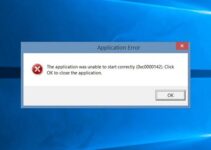In the realm of Windows operating systems, utilizing full screen mode is a common feature that enhances user experience, particularly while browsing, gaming, or using applications. However, there are instances when users need to exit this mode and return to the standard view.
This detailed article aims to shed light on the meaning of full screen mode in Windows, its uses, and various methods to exit full screen efficiently.

Understanding Full Screen Mode in Windows
Full screen mode in Windows allows applications or media to occupy the entire screen space, providing an immersive and distraction-free experience. This mode is particularly useful for activities like watching videos, playing games, or focusing on a specific task without the interference of other desktop elements.
Read Also:
- Clock_Watchdog_Timeout
- Disable Touch Screen Windows 10
- Getting Windows Ready Don’t Turn Off Your Computer
The Purpose of Full Screen Mode
- Enhanced Focus and Immersion: By removing the taskbar and other desktop icons, full screen mode helps users concentrate on the content.
- Optimized Use of Screen Real Estate: It maximizes the available display area, especially beneficial for users with smaller screens.
- Improved User Experience: For media and gaming, full screen mode can significantly enhance visual engagement and enjoyment.
Here the Guide, How To Exit Full Screen on Windows?
1.) F11 Key
The function keys are the row of keys on a keyboard located directly above the numeric keypad. The F1 through F12 keys do different things depending on the application you’re using.
Using the shortcut key F11, you may enter full-screen mode in many programmes, including browsers like Google Chrome and Mozilla Firefox. If you find yourself in full screen mode, though, you may always use F11 to minimise the window.
The F11 key may not always work unless the function (Fn) key is held down at the same time. To reduce the size of the keyboard without having to eliminate keys, it is common practise for laptop makers to assign many functions to a single key via the function key.
2.) Escape Key
If pressing F11 doesn’t do the trick, using Esc may do the trick. This isn’t going to work for everything, but it does help when F11 doesn’t, as while watching a YouTube video in full screen.
Alternatives to the Back Button to Leave Full Screen Mode
While the F11 or Escape keys are a frequent way out of full screen mode, some apps may not honour those shortcuts. If the other two keys don’t work to quit full screen mode, try these more standard methods.
1.) Simply hit the “X”
While this tip is specific to Google Chrome, it may theoretically be used to other programmes as well if they have the same functionality. Chrome’s full-screen mode can be exited by hovering the mouse pointer over the screen’s top right corner while in full-screen mode. If you want to leave full screen mode, just click the X there.
2.) F
Sometimes using the F key will cause the full screen mode of a currently playing video to be temporarily disabled. YouTube is the same way, and so are programmes like VLC.
3.) The Shortcut is Alt + Enter
Perhaps the most common method of activating full screen mode is by pressing the Alt and Enter keys simultaneously. Emulators, such as Snes9x, Project64, and Cemu, are notorious for this.
4.) Press the Windows Key + Letter M.
If you don’t want to leave full screen mode entirely but instead just want to minimise the window, use the Windows key plus M. This will reduce the size of all active windows, allowing you to return quickly to the desktop.
5.) Press the Windows Key + D.
Getting back to the desktop is as easy as pressing the Windows key plus the letter D. It functions similarly to the Windows key + M shortcut in that it minimises all open windows and takes you back to the desktop.
6.) Tab + Alt
Similarly to the preceding keys, you may use the combination of Alt + Tab to exit full screen mode and switch to another application. Pressing both of these keys simultaneously will take you to the previously selected window.
Alternatively, if you hit Tab while holding down the Alt key, a window selection overlay will appear, letting you pick from among all active windows. You can then select one of these windows by clicking on it, or you can cycle among them all by pressing Tab while holding down Alt.
7.) Alt + F4
Whether you’ve exhausted all other options with no success, try switching to full screen mode and seeing if the problem persists. If that’s the case, you can exit full-screen mode by pressing the Alt + F4 keys on your keyboard.
Tips for Managing Full Screen Settings
- Customize Shortcut Keys: Some applications allow you to customize keyboard shortcuts, including those for toggling full screen mode.
- Check Application Settings: Explore the settings or preferences menu in applications for options related to full screen mode.
- Update Graphics Drivers: Ensure your graphics drivers are up to date, as outdated drivers can sometimes affect full screen functionality.
- Familiarize with Game Settings: For gamers, familiarizing yourself with the game’s settings, including full screen options, can enhance the gaming experience.
Troubleshooting Full Screen Issues
Occasionally, users might encounter issues where they cannot exit full screen mode. Here are some troubleshooting steps:
- Restart the Application: Sometimes, simply closing and reopening the application can resolve full screen issues.
- Update Windows: Ensure your Windows operating system is up to date, as updates can fix bugs related to display and full screen problems.
- Check for Application Updates: Make sure the application you are using is updated to the latest version.
- Use Task Manager: If an application is unresponsive in full screen, use the Task Manager (Ctrl + Shift + Esc) to end the task and close the application.
Read Also:
Conclusion
Understanding how to navigate in and out of full screen mode is essential for Windows users to maximize their productivity and enjoyment. Whether for work or entertainment, being adept at managing full screen settings allows for a more controlled and tailored user experience.
While full screen mode offers many benefits, knowing how to quickly exit it ensures that you can effortlessly switch between tasks and manage your workflow effectively. Remember, the methods to exit full screen can vary depending on the application, so it’s beneficial to familiarize yourself with the specific functionalities of the software you use regularly.


